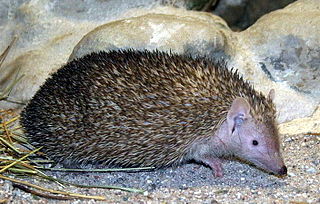
The order Afrosoricida contains the golden moles of Southern Africa, the otter shrews of equatorial Africa and the tenrecs of Madagascar. These three families of small mammals have traditionally been considered to be a part of the order Insectivora, and were later included in Lipotyphla after Insectivora was abandoned as a wastebasket taxon, before Lipotyphla was also found to be polyphyletic.

A tenrec is any species of mammal within the afrotherian family Tenrecidae endemic to Madagascar. Tenrecs are wildly diverse; as a result of convergent evolution some resemble hedgehogs, shrews, opossums, rats, and mice. They occupy aquatic, arboreal, terrestrial and fossorial environments. Some of these species, including the greater hedgehog tenrec, can be found in the Madagascar dry deciduous forests. However, the speciation rate in this group has been higher in humid forests.
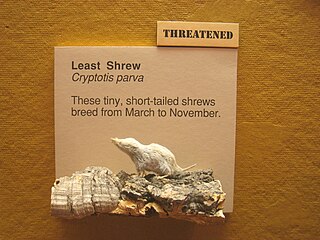
The genus Cryptotis is a group of relatively small shrews with short ears, which are usually not visible, and short tails, commonly called small-eared shrews. They have 30 teeth and are members of the red-toothed shrew subfamily. Since 1992, Neal Woodman at the United States National Museum has been in the process of revising the genus. To date, this has resulted in an increase in the number of species from 12 to 30.

The shrew moles or shrew-like moles (Uropsilus) are shrew-like members of the mole family of mammals endemic to the forested, high-alpine region bordering China, Myanmar, and Vietnam. They possess a long snout, a long slender tail, external ears, and small forefeet unspecialized for burrowing. Although they are similar to shrews in size, external appearance, and, presumably, ecological habits, they are nevertheless talpids and considered true moles, as they share a full zygomatic arch with all other moles, while this arch is completely absent in shrews.

The genus Crocidura is one of nine genera of the shrew subfamily Crocidurinae. Members of the genus are commonly called white-toothed shrews or musk shrews, although both also apply to all of the species in the subfamily. With over 180 species, Crocidura contains the most species of any mammal genus. The name Crocidura means "woolly tail", because the tail of Crocidura species are covered in short hairs interspersed with longer ones.
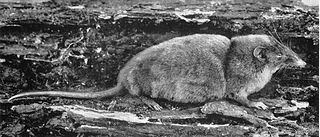
The hero shrew, also known as the armored shrew, is a large shrew native to the Congo Basin of Africa. Its features are typical of a white-toothed shrew − short legs, slender snout, dense fur − except for a highly unusual spinal column. It has corrugated interlocking vertebrae that are unique among mammals except for its sister species, Thor's hero shrew. This unique adaptation allows the animal to bear a huge amount of weight on its back − 72 kg (159 lb) according to an expedition team.

Suncus is a genus of shrews in the family Soricidae.
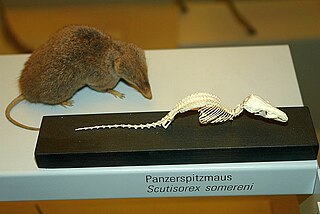
Scutisorex is a genus of African shrews, mammals of the family Soricidae. Members of the genus are the only known mammal species whose vertebrae interlock, a feature which, along with the general enlargement and strengthening of the backbone and ribs, allows them to bear remarkable loads. They also have well developed muscles for flexing their spine in the sagittal plane. It is thought that these adaptations allow the shrews to wedge open spaces between the trunks of palm trees and the stems of dead leaves, as well underneath logs and rocks, allowing them to partake of a reliable source of insect larvae and earthworms that would otherwise be inaccessible.

The Asiatic water shrews are the members of the genus Chimarrogale. They are mammals in the subfamily Soricinae of the family Soricidae. They are aquatic, with some species inhabiting streams. The genus contains the following species:
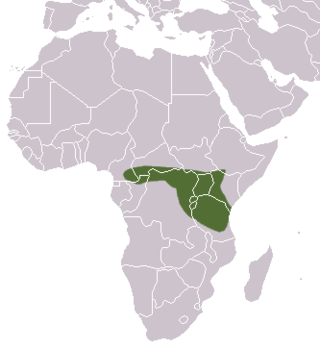
Hildegarde's shrew is a species of mammal in the family Soricidae. It is found in Burundi, Cameroon, Central African Republic, Republic of the Congo, Democratic Republic of the Congo, Ethiopia, Kenya, Rwanda, and Tanzania. Considered by some authorities to be a subspecies of Crocidura gracilipes, it is now recognised as a separate species, with a diploid chromosome number of 2n = 52. This is one of three species of small mammal named by the British zoologist Oldfield Thomas in honour of anthropologist Hildegarde Beatrice Hinde.
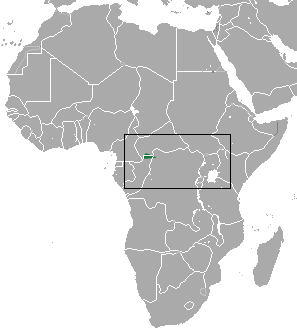
The Ugandan musk shrew is a species of mammal in the family Soricidae. It is found in Uganda, the Democratic Republic of Congo and the Central African Republic. Its range, population size and habits are poorly known.

Goodwin's broad-clawed shrew is a species of mammal in the shrew family, Soricidae. Body length and size of adults average 9.49 cm and 7.0 grams respectively making it a relatively larger shew. What distinguishes this from other shrews are its long claws.
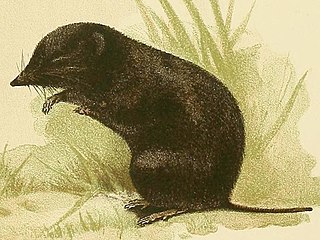
Myosorex is a mammal genus in the Soricidae (shrew) family. The genus, collectively referred to as the mouse shrews, contains these species:
Paracrocidura is a genus of shrews. They are mammals in the family Soricidae. The vernacular name large-headed shrews is sometimes collectively applied to the genus, but has also been applied to the species Crocidura grandiceps.

The Ruwenzori shrew is a species of mammal in the family Soricidae. It is the only species within the genus Ruwenzorisorex. It is found in Burundi, Democratic Republic of the Congo, Rwanda, and Uganda. It is semiaquatic, living along streams in tropical cloud forest.

The forest shrews are the members of the genus Sylvisorex. They are mammals in the family Soricidae and are found only in Africa. The genus name comes from the Latin world "silva" which means "forest" and "sorex", which means "shrew-mouse". This reflects the nature of these shrews, which prefer forest habitats. All shrews are carnivorous, and eat continually to satisfy their high metabolic rate.

Asian mole shrews (Anourosorex) are a genus of shrews that resemble moles, from China, Taiwan, India, and Indochina. They are the only known genus of the Anourosoricini tribe of red-toothed shrews. The four known species are:















